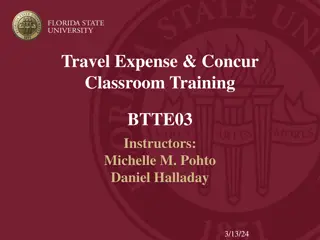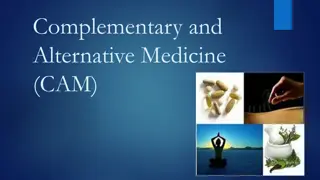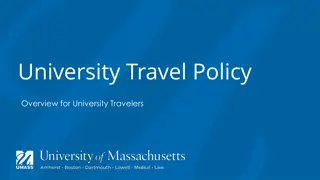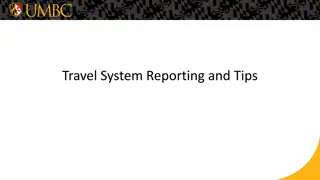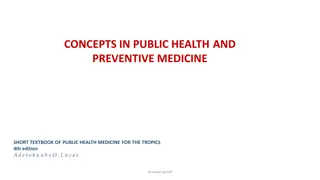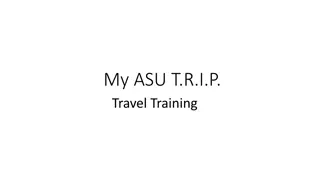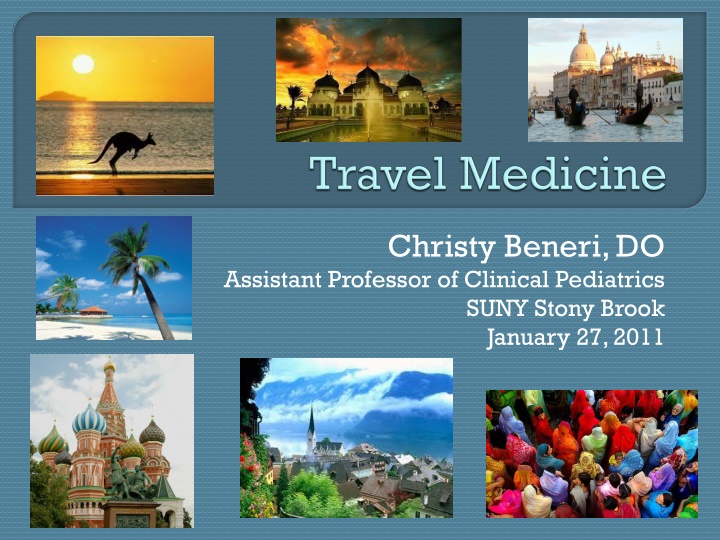
Travel Medicine Insights: Global Trends and Recommendations
Explore key insights into travel medicine, including current travel advice, common infections in returning travelers, and the importance of referrals to travel medicine experts. Gain valuable knowledge on international travel trends, health risks, and the need for pre-travel consultations and immunizations to ensure a safe and healthy journey.
Download Presentation

Please find below an Image/Link to download the presentation.
The content on the website is provided AS IS for your information and personal use only. It may not be sold, licensed, or shared on other websites without obtaining consent from the author. If you encounter any issues during the download, it is possible that the publisher has removed the file from their server.
You are allowed to download the files provided on this website for personal or commercial use, subject to the condition that they are used lawfully. All files are the property of their respective owners.
The content on the website is provided AS IS for your information and personal use only. It may not be sold, licensed, or shared on other websites without obtaining consent from the author.
E N D
Presentation Transcript
Christy Beneri, DO Assistant Professor of Clinical Pediatrics SUNY Stony Brook January 27, 2011
1. Review current travel advice and immunizations based on travel locations 2. Recognize possible infections in returning travelers 3. Better identify the need for referrals to travel medicine experts
Globally, >750 million people traveled internationally in 20041 About 4% are children About 8% of travelers seek medical care while abroad or on returning home 22-64% of travelers to the developing world report health problems Nationally, >64 million trips outside the US, a 21% increase since 19972 1. Long S et al. Principles and Practices of Pediatric Infectious Diseases. 2003. Chapter 9;79-86 2. Yellow Book 2010
In one study 1,254 travelers departing from Boston Logan International Airport completed a survey. The survey revealed that: 38% traveling to low-low/middle income countries and 62% to upper-middle or high income countries 54% of traveler s to LLMI countries pursued advice prior to travel Most sighted reason for not seeking advice was lack of concern regarding health problems related to trip LaRocque et al. J of Trav Med. 2010;17(6):387-391
Web based data collection, 17,353 ill returned travelers at 31 clinical sites on six continents Individual diagnoses put into syndrome groups and examined for all regions together 226 per 1000 had systemic febrile illness, 222 acute diarrhea, 170 dermatologic disorder, 113 chronic diarrhea and 77 respiratory disease Freedman et al. NEJM. 2006;354(2):119-30
FEBRILE ILLNESS IS MOST LIKELY FROM AFRICA AND SOUTHEAST ASIA. MALARIA IS AMONG THE TOP THREE DIAGNOSES FROM EVERY REGION. OVER THE PAST DECADE DENGUE HAS BECOME THE MOST COMMON FEBRILE ILLNESS FROM EVERY REGION OUTSIDE SUB- SAHARAN AFRICA. IN SUB-SAHARAN AFRICA, RICKETTSIAL DISEASE IS SECOND ONLY TO MALARIA AS A CAUSE OF FEVER. RESPIRATORY DISEASE IS MOST LIKELY IN SOUTHEAST ASIA. ACUTE DIARRHEA IS DISPROPORTIONATELY SEEN IN TRAVELERS FROM SOUTH CENTRAL ASIA. Freedman et al. NEJM. 2006;354(2):119-30 Yellow Book 2010
With the extent of international travel, physicians need to be knowledgeable on the travel advice they give to patients Appropriate travel advice avoids mishaps including injury and illness during travel and ensures a good memorable travel experience
Should at least occur 4-6 weeks prior to travel Review entire trip itinerary Destinations, time/duration of travel, accommodations, planned activities, exposures to insects/animals Review patient s current and past medical history Review immunization history, medications, and allergies Remember to include children of immigrants returning to their home countries to visit relatives and friends
Requires skill, time, knowledge base and comfort, helps when you have been there Vaccinations- required, recommended, routine Malaria Prophylaxis Other Insect/Vector Borne Risks Travelers Diarrhea Other Destination Risks water, food and safety precautions
Routine Immunizations Required Immunizations Recommended Immunizations
While immunization rates have increased over the past several years, a significant number remain unimmunized Many vaccine preventable diseases are endemic in most of the world Therefore, children should be brought up to date with routine immunizations Accelerated dosing schedules may be used
Vaccine Combined Hepatitis A and B* Earliest Age for 1st Dose Min. Interval between Doses 1 year 1 wk, 2 wks between 2nd and 3rd doses (booster after 1 yr) 6 mos 4 wks, 6 mos between 3rd and 4th doses 4 wks 4 wks 4 wks (booster after 1 yr) 4 wks, 8 wks between 2nd and 3rd doses (give 3rd dose > 16 wks after 1st dose) 4 wks, 8 wks between 3rd and 4th doses Hepatitis A DTaP IPV OPV* Hib Hepatitis B 1 year 6 weeks 6 weeks birth 6 weeks birth PCV7 6 weeks 6 mos followed by MMR at 12 mos and at 4-6 years of age Measles 4 wks Varicella 12 months 4 wks if > 13 y/o 3 mos if < 13 y/o *Only outside US
Polio In the US, OPV is not available; IPV can be given as young as six weeks Do not give OPV to patients with immunodeficiencies MMR Infants between 6-12 months traveling to a measles endemic area should receive 1 dose of measles (or MMR) vaccine prior to travel
Hepatitis A Most cases are imported into the U.S. by travelers from Mexico and Central America Infants < 12 months of age should receive Hepatitis A IG (0.02 ml/kg IM for travel <3 months or 0.06 ml/kg IM for travel > 3 months)
Influenza Seasonal influenza vaccines for all travelers 6 months of age and older Pertussis Tdap booster should be given starting at 11 years of age
Polio For previously immunized adult travelers to polio-endemic areas (Africa, Asia), consider vaccination with an additional dose of IPV Only 1 lifetime booster of IPV is necessary
Typhoid vaccines Asia, Africa, Central and South America, Caribbean Contraindications: hypersensitivity, malignancies Precautions: pregnancy
Oral vaccine (Ty21a) Live attenuated vaccine > 6 y/o; provides 5 years of immunity Do not take concurrently with proguanil, mefloquine, or chloroquine (antimalarials) Adverse effects: abdominal pain, N,/V, F, HA, rash Typhoid IM vaccine (ViCPS) Purified, killed capsular polysaccharide vaccine > 2 y/o; provides 2 years of immunity Adverse effects: F, HA, local reaction
Type of vaccine Live attenuated Killed Route Oral Intramuscular Minimum age of receipt Age >6 yrs Age >2 yrs # of doses 4 1 Booster frequency 5 2 Adverse effects (incidence) <5 % <7%
Rabies Vaccine Travelers with occupational risk, outdoor travelers Vaccine series: 3 IM doses of 1 ml (0, 7, and 21 or 28 days) Human diploid cell vaccine or purified chick embryo cell vaccine If bitten by potentially rabid animal, 2 additional doses are needed but no RIG Wash area with soap and water
Japanese Encephalitis Virus Arboviral infection transmitted by Culex mosquitos F, HA, N/V, meningitis/encephalitis About 50% have neurologic abnormalities and fatality rate is 25% JE vaccine Recommended for all travelers > 12 m/o traveling to endemic areas for > 1 month (rural East Asia, SE Asia) 3 doses given over 2-4 weeks; give last dose at least 10 days before travel and observe for 30 min after each dose Duration of immunity unknown
Meningococcal Vaccine (MCV) IM Quadrivalent conjugate vaccine (A, C, Y, W-135) Most common serogroups in US: B, C, Y Most common serogroups in sub-Saharan Africa: A, C, W-135 Protects against meningococcemia and meningitis Required for travelers to Hajj and the meningitis belt from December June MCV is preferred over MPSV4 for children 2 through 10 years of age
Meningococcal Vaccine (MCV) Contraindications: hypersensitivity, previous GBS Adverse effects: injection site reactions, hypersensitivity (rare)
The Meningitis Belt
Yellow fever Arboviral infection transmitted by Aedes and Haemogogus mosquitos F, HA, N/V, myalgia, photophobia and restlessness, myocardial dysfunction and fulminant hepatitis YF Vaccine Live attenuated International certificate of vaccination for all entering travelers Effective after 10 days; booster required every 10 yrs Contraindications: egg allergy, immunosuppression; Cautions: pregnancy, elderly Adverse effects: F, HA, rash; vaccine-associated encephalitis syndrome (rare: 0.5-4 per 1000 infants); vaccine-associated viscerotropic disease
(CDC, Division of Vector-Borne Infectious Diseases, 2005)
Malaria Dengue
Infection occurs via infected female Anopheles mosquito Most commonly caused by Plasmodium species P. falciparum most lethal and drug resistant P. vivax Central America, Indian subcontinent P. ovale western sub-Saharan Africa P. malariae A worldwide leading cause of death in children under 5 500 million infections and > 1 million deaths annually
Highest Risk of Disease Young children Pregnant women Those without prior exposure Lower Risk of Disease Air-conditioned housing Screened housing No vaccine available
Clinical presentation F, HA, myalgias, malaise; anemia, jaundice P. falciparum: seizures, mental confusion, renal failure, coma, death Symptoms may present 7 days after exposure to several months after return from an endemic area
Personal protective measures Bed nets * Clothing that covers most of the body Insect repellant: DEET Use > 30% DEET Not for infants < 2 m/o Apply to your hands first before applying to young children Insecticide (permethrin) coated clothing and bed nets
Country specific and altitude specific Dependent on patient s medical history Chemoprophylaxis is not 100% effective Started prior to travel, during travel, and after return http://t3.gstatic.com/images?q=tbn:s4tTuvWDYqp2GM:http://www.britsincancun.com/images/rx.jpg
Chloroquine sensitive areas Central America, Argentina, parts of the Middle East Chloroquine Chloroquine resistant areas All other areas Mefloquine Atovaquone/proguanil Doxycycline Primaquine
Drug of choice where parasites are sensitive Adverse effects GI, HA, dizziness, blurred vision, insomnia Caution: may worsen psoriasis
May be used in children of any weight Avoid in resistant areas (Thailand, Myanmar, Cambodia) Adverse effects GI, HA, insomnia, abnormal dreams, visual disturbances Rare: reversible neuropsychiatric reaction, seizures Contraindications Psychiatric disorders, seizures Caution: history of psych disorders, cardiac conduction disorders
Daily dosing Take with food Adverse effects GI, HA Contraindications Severe renal impairment (Cr Cl < 30 ml/min) Infants < 5 kg Pregnant women
Daily dosing Adverse effects GI, photosensitivity, candidal vaginitis Contraindications G6PD deficiency (fatal hemolysis) exclude prior to use Pregnancy, lactation
Transmitted by Aedes mosquitoes Endemic and epidemic in Asia, Latin America, and Africa 159 cases per 1,000 travelers to Southeast Asia during epidemic years Outbreaks have occurred in southern Texas and Hawaii
Classic dengue fever asymptomatic to mild systemic illness Estimated 100 million cases annually Acute F, HA (retro-orbital), myalgia, arthralgia, V, abdominal pain, rash 1% progress to dengue hemorrhagic fever (DHF) DHF and dengue shock syndrome (DSS) Increased vascular permeability on 3rd-7th day of illness Hepatitis, myocarditis, neurologic symptoms; shock Treatment: rest, hydration, supportive care
One of the most common illnesses affecting travelers; 9-40% of all children Highest rates, longest duration, and greatest severity in children < 3 y/o Etiologies Bacteria 80-85% Parasites 10% Viruses 5%
Pathogens are isolated 30-60% of the time Enterotoxigenic E. coli (ETEC) Most common cause worldwide Large inoculum Enteroaggregative E. coli (EAEC) Salmonella, Campylobacter, Shigella, Vibrio Parasites: Giardia, Cryptosporidium, Entamoeba Viruses: rotavirus, norovirus
Less common than travelers diarrhea Ingestion of pre-formed toxins V > D Usually resolves within 12-18 hours



